Optimal Design Model for a Residential PV Storage System an Application to the Spanish Case
Abstract
1. Introduction
2. Methods and Materials
2.1. A Model for Energy Self-Consumption Using PV Panels
- (1)
- An hourly PV energy generation EPV.
- (2)
- The hourly demand profile, ED.
- (3)
- The energy price (PE) and access tariff (AT).
- (4)
- The round trip efficiency of the BESS (η).
- (5)
- The daily peak hours and off-peak hours.
- BESS level constraint:
- PV outflow constraints:
- Self-consumption constraints:
- Surplus energy constraint:
- Hourly demand constraints:
2.2. Model Input Information
2.2.1. Demand Profile
2.2.2. Energy Price and Tariffs
2.2.3. Technology of the Facility
2.2.4. Location and Energy Production
3. Technical and Financial Results of the Self-consumption Model
3.1. Household PV Panels Without Storage
3.2. Household PV Panels with Storage
4. Discussion
5. Conclusions
Author Contributions
Funding
Institutional Review Board Statement
Informed Consent Statement
Data Availability Statement
Acknowledgments
Conflicts of Interest
Nomenclature
| BESS | Battery Energy Storage Systems |
| BoS | Balance of Systems |
| EPC | Engineering Procurement and Construction |
| EU | European Union |
| HDT | Hourly Discrimination Tariff |
| IRENA | International Renewable Energy Agency |
| LCOE | Levelized Cost Energy |
| Li-ion | Lithium-Ion |
| OMIE | Iberian Electricity Market Operator |
| PV | Photovoltaic |
| PVGIS | Photovoltaic Geographical Information System |
| ROI | Return On Investment |
| VAT | Value Added Tax |
| Variables | |
| AT | Access tariffs (€/kWh) |
| Cost of the battery (€) | |
| CF | Cash Flow (€) |
| CoP | Contrated power (kW) |
| Cost of the PV panels (€) | |
| Unitary cost of the battery (€/kWh) | |
| Unitary cost of the PV panels (€/kWh) | |
| D | Annual demand of the household (kWh) |
| Energy level of the battery (kWh) | |
| Energy supplied by the battery (kWh) | |
| Energy supplied by the PV panels and directly consumed by the household(kWh) | |
| Energy from PV panels used to charge the battery (kWh) | |
| Energy demand mean (kWh) | |
| Energy demanded by the household (kWh) | |
| Surplus energy generated by the PV panels over the household demand (kWh) | |
| Total energy consumed from facility (kWh) | |
| Energy generation mean (kWh) | |
| Energy purchased in the market (kWh) | |
| Total energy generated by the PV panels (kWh) | |
| Energy sold and injected into the market (kWh) | |
| I | Investment (€) |
| IC | Incomes from the energy sale (€) |
| IR | Investment return (%) |
| IRR | Internal rate of return |
| k | Interest rate (%) |
| N | Normal Distribution |
| NPV | Net present value (€) |
| Capacity of the battery (kWh) | |
| PE | Price of energy (€/kWh) |
| PP | Price of the contrated power (€/kWh x year) |
| Power of PV panel (kWp) | |
| S | Saving in the energy consumption (€) |
| t | Year of the project (year) |
| Error term of the energy generation (kWh) | |
| Error term of the energy demand (kWh) | |
| η | Round trip efficiency of the battery (%) |
| σu | Standard deviation of normal distribution |
References
- European Parliament. Council of the EU Directive (EU) 2019/944 on Common Rules for the Internal Market for Electricity and Amending Directive 2012/27/EU; European Parliament: Brussels, Belgium, 2019; Volume 944.
- Ministerio de Transición Ecológica. Royal Decree 244/2019; Ministerio de Transición Ecológica: Madrid, Spain, 2019.
- Arcos, A. Un nuevo modelo de mercado eléctrico europeo: The citizen is king. DYNA Ingenieria e Industria 2019, 94, 590–591. [Google Scholar] [CrossRef]
- Dusonchet, L.; Telaretti, E. Economic analysis of different supporting policies for the production of electrical energy by solar photovoltaics in Western European Union countries. Energy Policy 2010, 38, 3297–3308. [Google Scholar] [CrossRef]
- Campoccia, A.; Dusonchet, L.; Telaretti, E.; Zizzo, G. An analysis of feed-in tariffs for solar PV in six representative countries of the European Union. Sol. Energy 2014, 107, 530–542. [Google Scholar] [CrossRef]
- Del Rio, P.; Mir, P. Support for solar PV deployment in Spain: Some policy lessons. Renew. Sustain. Energy Rev. 2012, 16, 5557–5566. [Google Scholar] [CrossRef]
- Bayod, A.; Burgio, A.; Leonowicz, Z.; Mennit, D.; Pinnarelli, A.; Sorrentino, N. Recent developments of photovoltaics integrated with battery storage systems and related feed-in tariff policies: A review. Int. J. Photoenergy 2017, 2017. [Google Scholar] [CrossRef]
- Del Coso, G.; Del Canizo, C.; Sinke, W.C. The impact of silicon feedstock on the PV module cost. Sol. Energy Mater. Sol. Cells 2010, 94, 345–349. [Google Scholar] [CrossRef]
- Chen, K. Technology improves solar PV competitiveness. Electr. Light Power 2011, 89, 48. [Google Scholar]
- Zhu, D.; Wang, Y.; Yue, S.; Xie, Q.; Pedram, M.; Chang, N. Maximizing return on investment of a grid-connected hybrid electrical energy storage system. In Proceedings of the 18th Asia and South Pacific Design Automation Conference (IEEE), Yokohama, Japan, 22–25 January 2013; pp. 638–643. [Google Scholar] [CrossRef]
- Zhang, H.; Van Gerven, T.; Baeyens, J.; Degrève, J. Photovoltaics: Reviewing the European feed-in-tariffs and changing PV efficiencies and costs. Sci. World J. 2014, 2014. [Google Scholar] [CrossRef]
- Ghiassi-Farrokhfal, Y.; Kazhamiaka, F.; Rosenberg, C.; Keshav, S. Optimal design of solar PV farms with storage. IEEE Trans. Sustain. Energy 2015, 6, 1586–1593. [Google Scholar] [CrossRef]
- Lorenzi, G.; Santos, C. Comparing demand response and battery storage to optimize self-consumption in PV systems. Appl. Energy 2016, 180, 524–535. [Google Scholar] [CrossRef]
- Mondol, J.; Hillebrand, S. Grid parity analysis of solar photovoltaic systems in Europe. Int. J. Ambient Energy 2014, 35, 200–210. [Google Scholar] [CrossRef]
- Chiacchio, F.; D’urso, D.; Aizpurua, J.; Campagno, L. Performance assessment of domestic photovoltaic power plant with a storage system. IFAC PapersOnLine 2018, 51, 746–751. [Google Scholar] [CrossRef]
- Chiacchio, F.; Famoso, F.; D’urso, D.; Cdola, L. Performance and economic assessment of a grid-connected photovoltaic power plant with a storage system: A comparison between the North and the South of Italy. Energies 2019, 12, 2356. [Google Scholar] [CrossRef]
- Shin, H.; Geem, Z.W. Optimal design of a residential photovoltaic renewable system in South Korea. Appl. Sci. 2019, 9, 1138. [Google Scholar] [CrossRef]
- Zhu, D.; Wang, Y.; Chang, N.; Pedram, M. Optimal design and management of a smart residential PV and energy storage system. In Proceedings of the Design, Automation, Test in Europe Conference and Exhibition (IEEE), Dresden, Germany, 24–28 March 2014; pp. 1–6. [Google Scholar] [CrossRef]
- Talavera, D.; Muñoz, E.; Ferrer, J.; Nofuentes, G. Evolution of the cost and economic profitability of grid-connected PV investments in Spain: Long-term review according to the different regulatory frameworks approved. Renew. Sustain. Energy Rev. 2016, 66, 233–247. [Google Scholar] [CrossRef]
- Colmenar, A.; Campíñez, S.; Pérez, C.; Castro, M. Profitability analysis of grid-connected photovoltaic facilities for household electricity self-sufficiency. Energy Policy 2012, 51, 749–764. [Google Scholar] [CrossRef]
- Bernal, J.; Dufo, R. Economical and environmental analysis of grid connected photovoltaic systems in Spain. Renew. Energy 2006, 31, 1107–1128. [Google Scholar] [CrossRef]
- Lopez, J.; Steinenger, K. Photovoltaic self-consumption regulation in Spain: Profitability analysis and alternative regulation schemes. Energy Policy 2017, 108, 742–754. [Google Scholar] [CrossRef]
- Rosales, E.; Simon, M.; Borge, B.; Perez, A.; Colmenar, A. An expert judgement approach to determine measures to remove institutional barriers and economic non-market failures that restrict photovoltaic self-consumption deployment in Spain. Sol. Energy 2019, 180, 307–323. [Google Scholar] [CrossRef]
- Sarasa, C.; Dufo, R.; Bernal, J. Evaluating the effect of financing costs on PV grid parity by applying a probabilistic methodology. Appl. Sci. 2019, 9, 425. [Google Scholar] [CrossRef]
- Hinestroza, J. Autoconsumo residencial: Análisis de rentabilidad y tamaño óptimo. In Trabajo Final de Carrera; Universidad de Sevilla (US): Seville, Spain, 2019. [Google Scholar]
- Arcos, Á.; Cansino, J.; Román, R. Economic and environmental analysis of a residential PV system: A profitable contribution to the Paris agreement. Renew. Sustain. Energy Rev. 2018, 94, 1024–1035. [Google Scholar] [CrossRef]
- Zhang, Z. Smart grid in America and Europe. Public Util. Fortn. 2011, 149, 32–40. [Google Scholar]
- Arcos, A.; Lugo, D.; Núñez, F. Residential peak management: A storage and control system application taking advantages of smart meters. Energy Syst. 2018, 102, 110–121. [Google Scholar] [CrossRef]
- OMIE, Iberian Electricity Market Operator. Available online: https://www.omie.es/es/market-results/daily/daily-market/daily-hourly-price (accessed on 23 July 2020).
- Carbonero, A. Efecto sobre el bienestar económico de un aumento en la potencia instalada fotovoltaica. Una aplicación al sistema eléctrico español. In Trabajo final de Carrera; Universidad de Sevilla (US): Seville, Spain, 2018. [Google Scholar]
- Jäger-Waldau, A. PV Status Report 2019, EUR 29938 EN; Publications Office of the European Union: Luxembourg, 2019. [Google Scholar] [CrossRef]
- Keiner, D.; Manish, R.; Barbosa, L.; Bogdanov, D.; Breyer, C. Cost optimal self-consumption of PV prosumers with stationary batteries, heat pumps, thermal energy storage and electric vehicles across the world up to 2050. Sol. Energy 2019, 185, 406–423. [Google Scholar] [CrossRef]
- Ram, M.; Bogdanov, D.; Aghahosseini, A.; Oyewo, S.; Gulagi, A.; Child, M.; Breyer, C.; Caldera, U.; Sadovskaia, K.; Farfan, J.; et al. Global Energy System Based on 100% Renewable Energy—Power, Heat, Transport and Desalination Sectors; Study by Lappeenranta University of Technology and Energy Watch Group: Lappeenranta, Finland; Berlin, Germany, 2019. [Google Scholar]
- European Commission, Joint Research Centre. Photovoltaic Geographical Information System—Interactive Maps. PVGIS. Available online: https://re.jrc.ec.europa.eu/pvg_tools/es/#PVP (accessed on 19 July 2020).
- Arcos, A.; Canca, D.; Núñez, F. Impact of battery technological progress on electricity arbitrage: An application to the Iberian market. Appl. Energy 2020, 260, 114273. [Google Scholar] [CrossRef]
- Gómez, A.; Sudria, A.; Alvarez, E.; Díaz, J.; Pérez, J.; Arcos, A.; Pérez de Vargas, J. El Almacenamiento de Energía en la Distribución Eléctrica del Future; Real Academia de la Ingeniería: Madrid, Spain, 2017. [Google Scholar]
- Segui, P. Todo Sobre Baterías y Almacenamiento de Energía. Available online: https://www.barriolapinada.es/baterias-almacenamiento-energia/ (accessed on 19 July 2020).
- Bardo, S. Almacenamiento distribuido en viviendas para alisar la curva de demanda de energía eléctrica. In Trabajo Final de Carrera; Universitat Politècnica de Catalunya (UPC): Barcelona, Spain, 2010. [Google Scholar]
- Hernández, A. Análisis económico de un sistema de almacenamiento para la disminución de desvíos de producción en un parque eólico. In Trabajo Final de Master; Escuela Técnica Superior de Ingeniería: Seville, Spain, 2016. [Google Scholar]
- Battery University. Learn About Batteries. Available online: https://batteryuniversity.com/learn/ (accessed on 19 July 2020).
- Jofemar Energy. Almacenamiento Electroquímico con Baterías de Flujo. Available online: http://www.f2e.es/uploads/doc/20160704075330.f2e_jofemar.pdf (accessed on 19 July 2020).
- Vélez, S. Estudio de un sistema de almacenamiento de energía eólica por medio de baterías. In Trabajo Final de Carrera; Universidad Politécnica de Madrid (UPM): Madrid, Spain, 2012. [Google Scholar]
- Clean Technica. Batteries Keep on Getting Cheaper. Available online: https://cleantechnica.com/2017/12/11/batteries-keep-getting-cheaper/ (accessed on 19 July 2020).
- IRENA. Accelerating the global energy transformation. In International Renewable Energy Agency; United Arab Emirates: Abu Dhabi, UAE, 2017. [Google Scholar]
- Comisión Nacional de los Mercados y la Competencia. Available online: https://www.cnmc.es/2018-11-02-la-cnmc-publica-la-metodologia-de-calculo-de-la-tasa-de-retribucion-financiera-de-las (accessed on 19 July 2020).
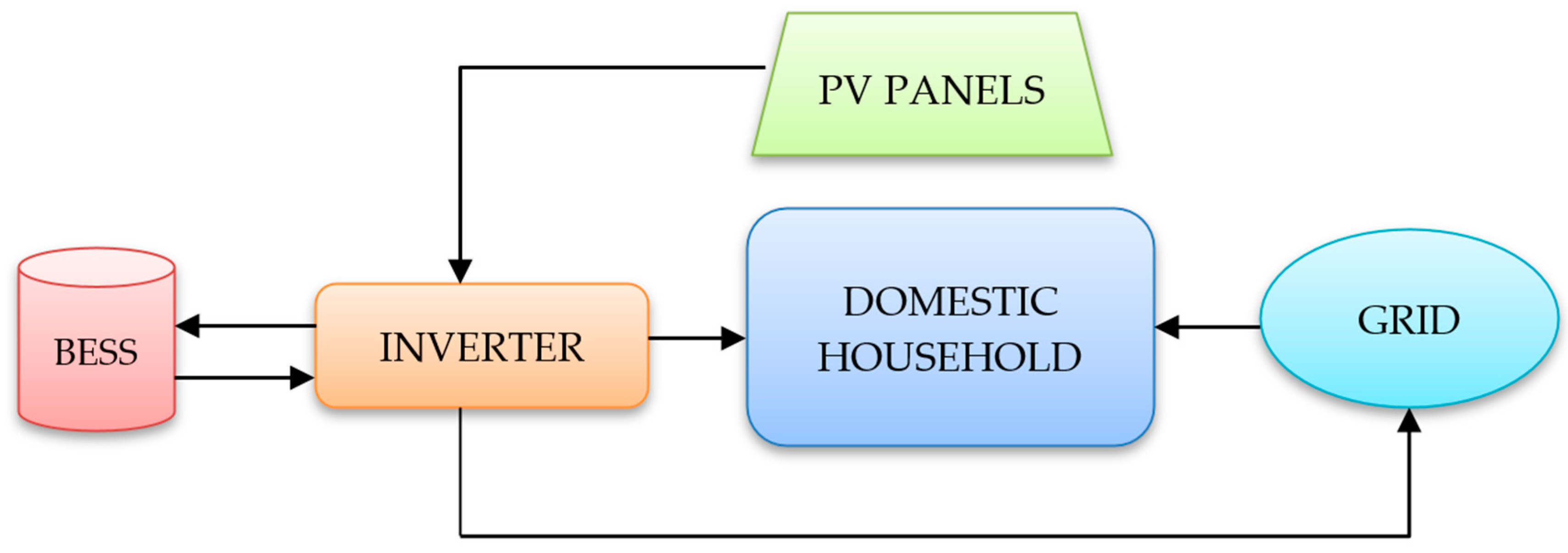
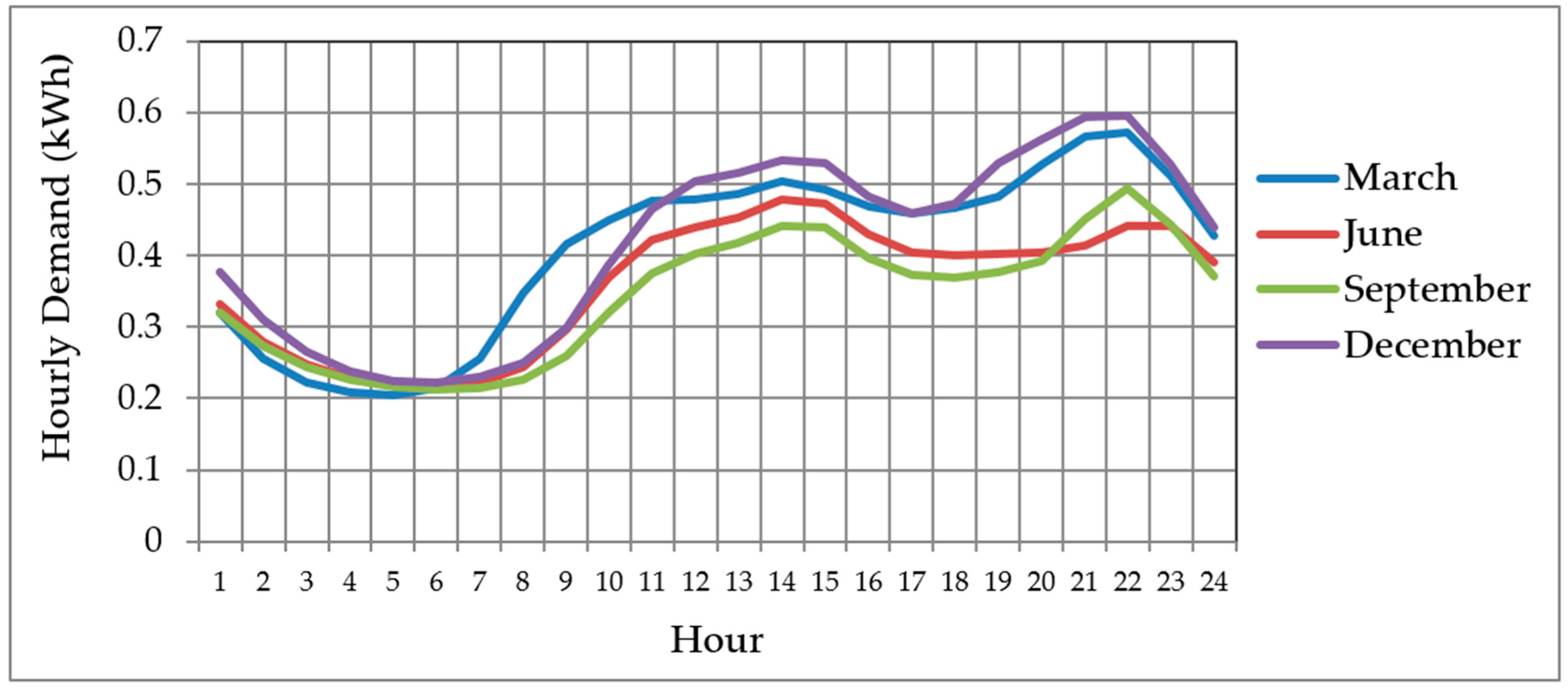
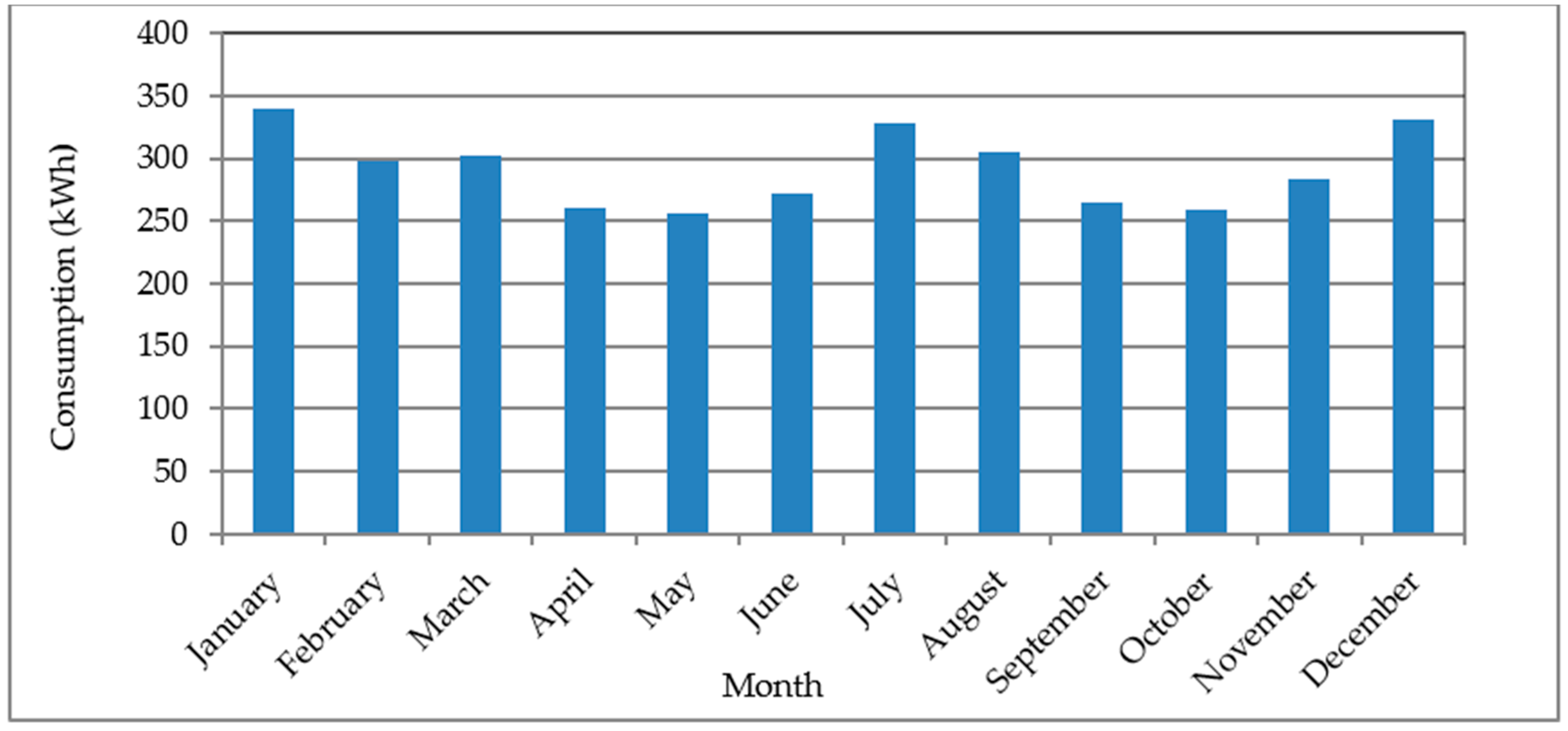

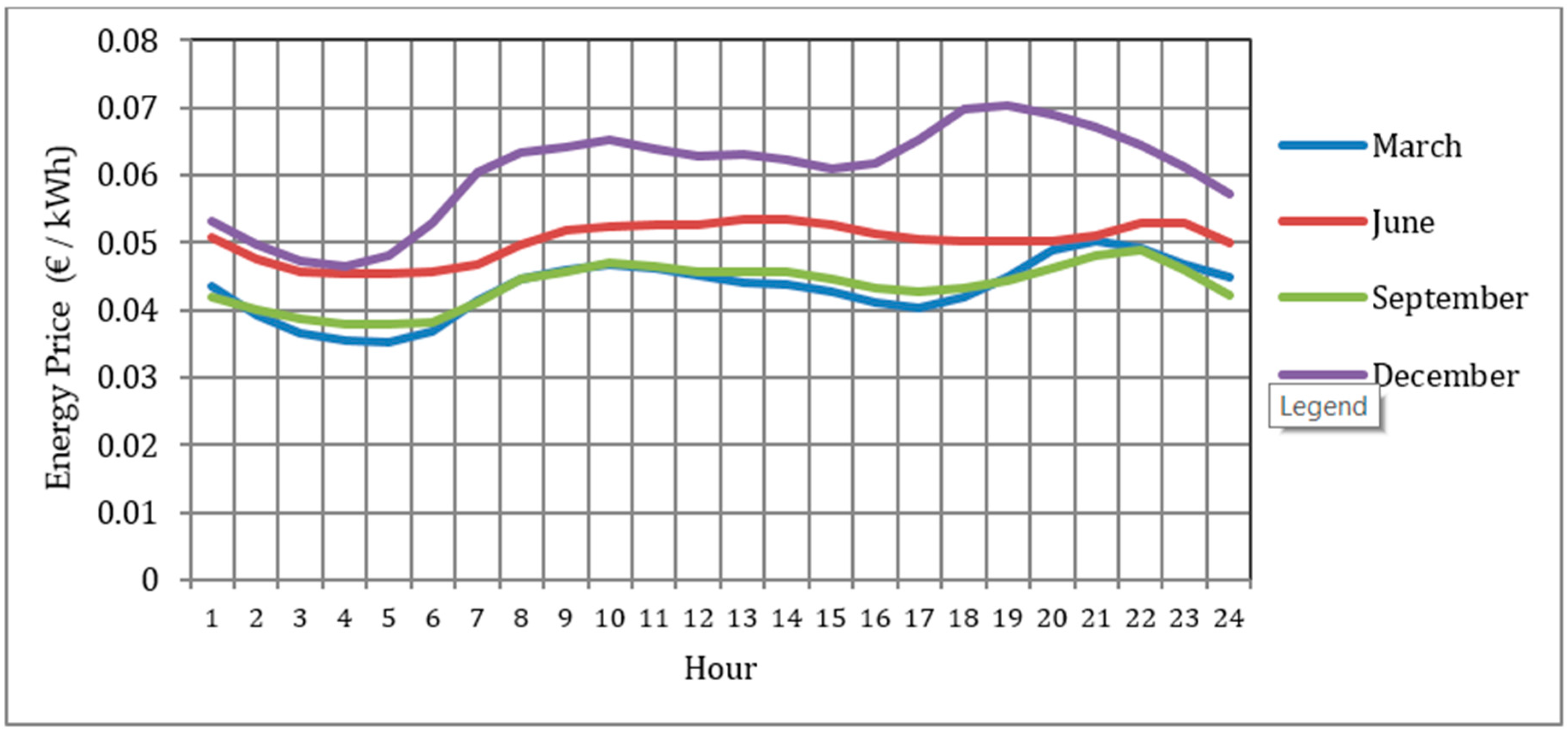

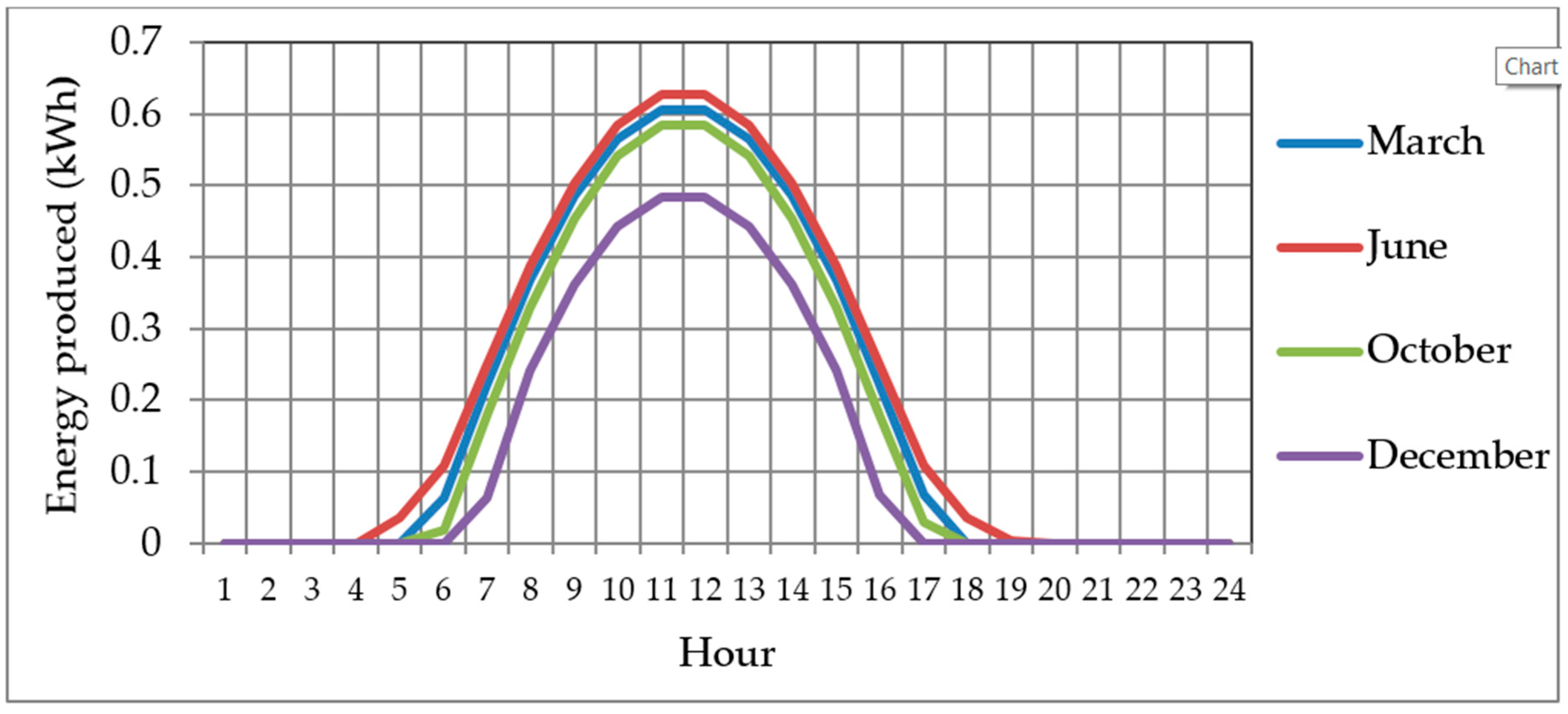
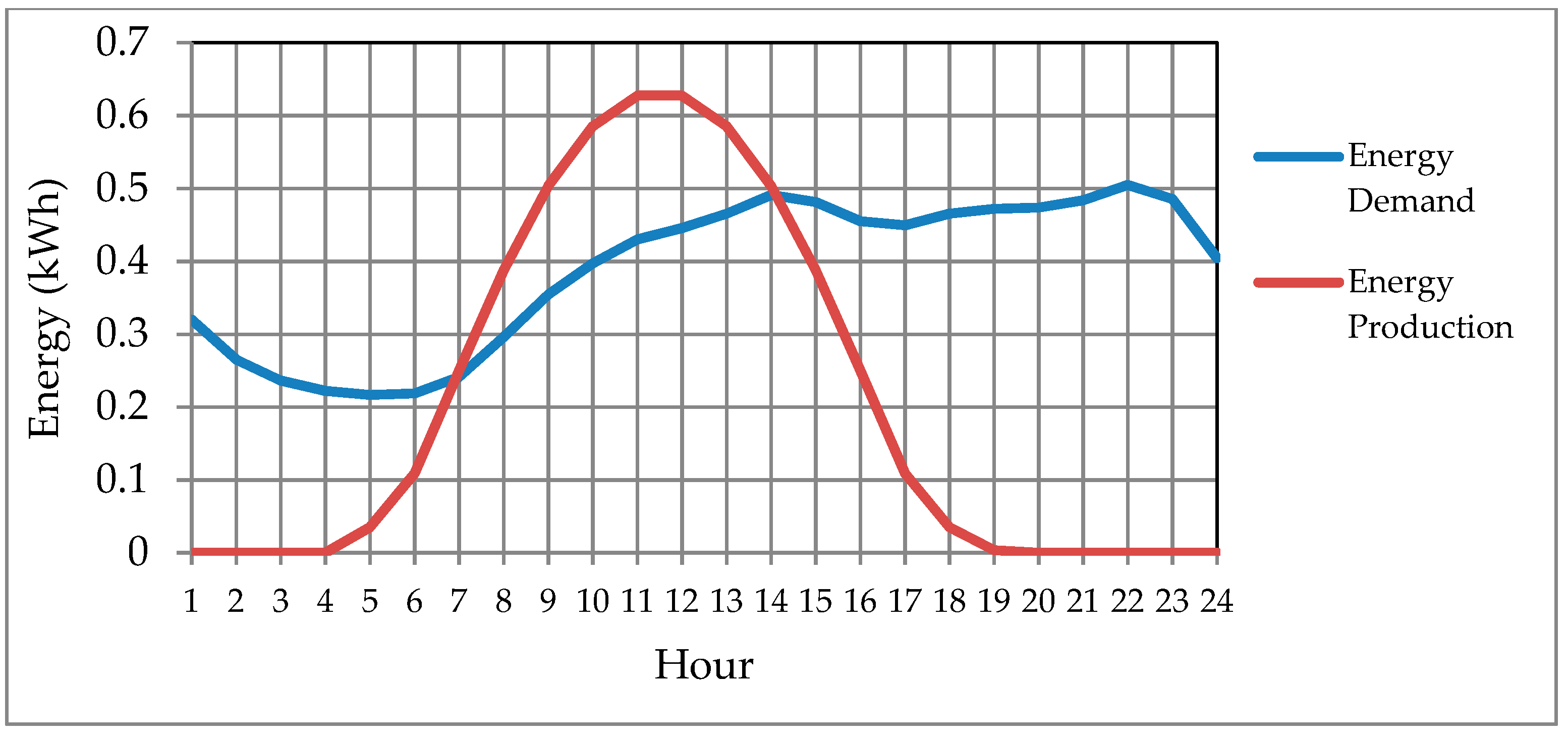
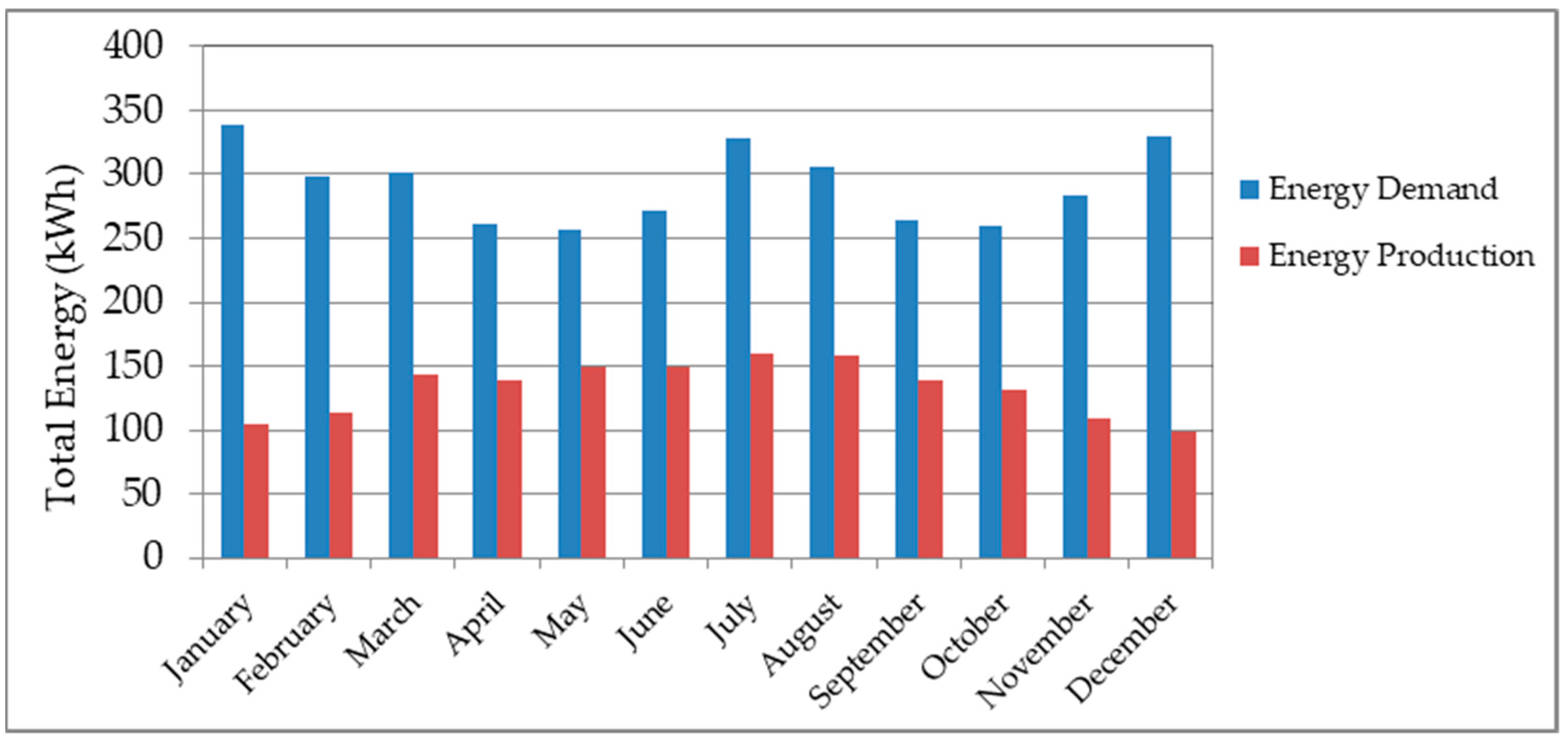
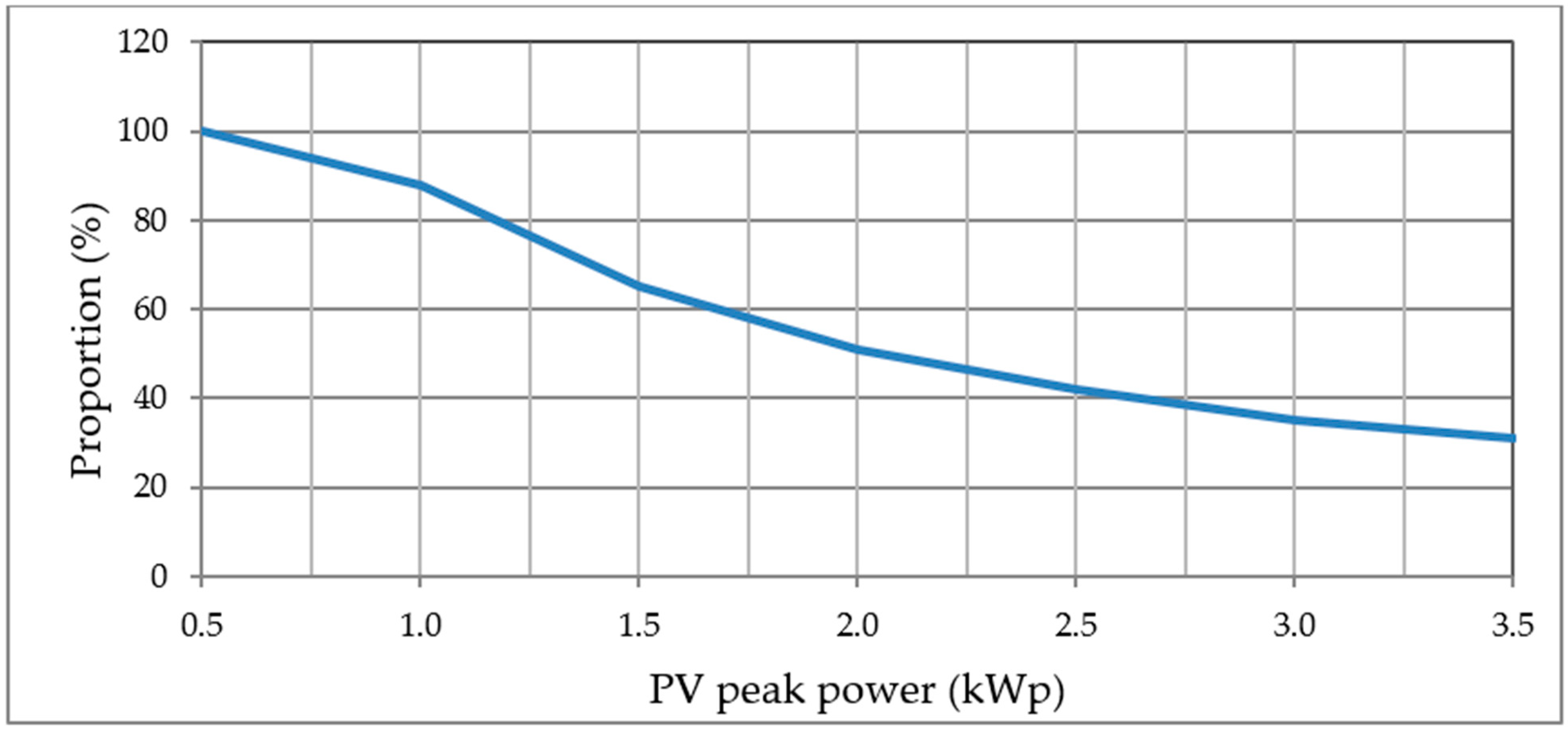
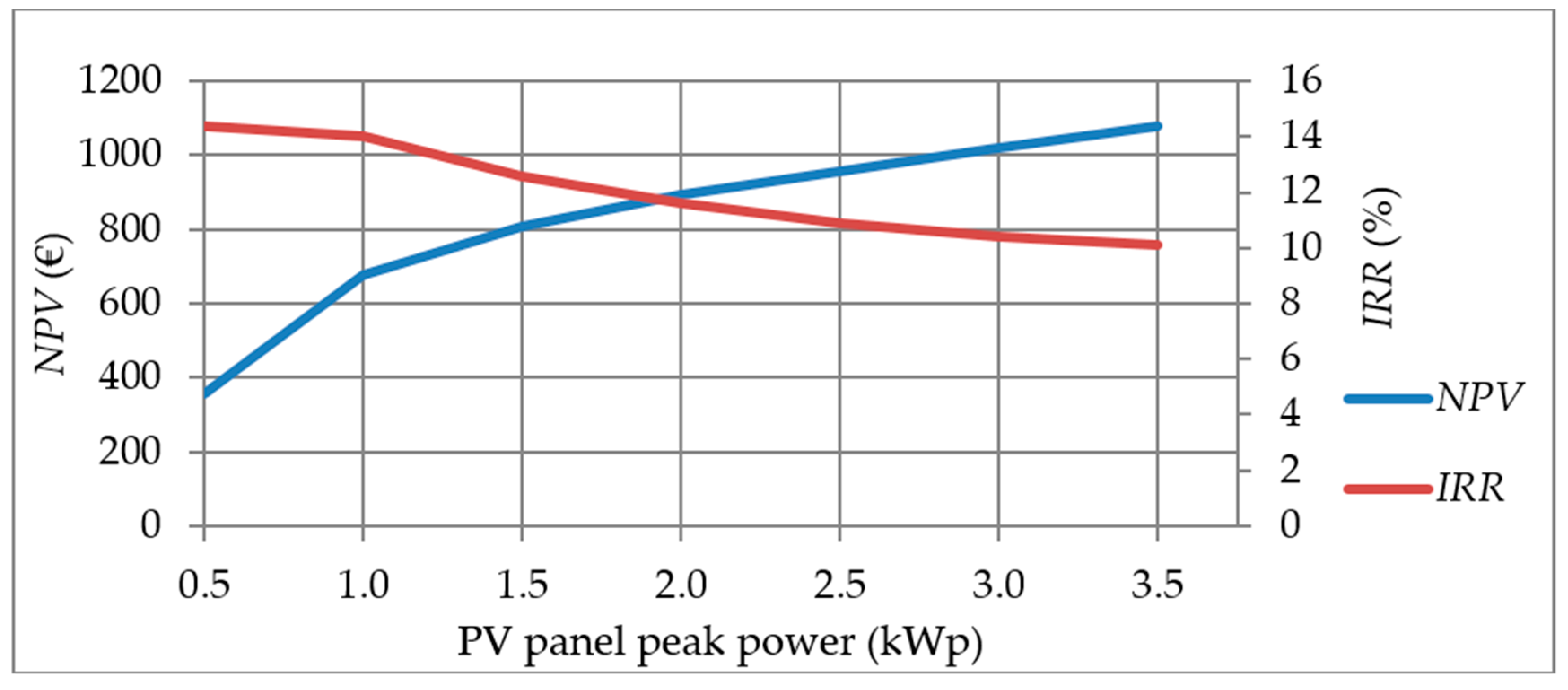
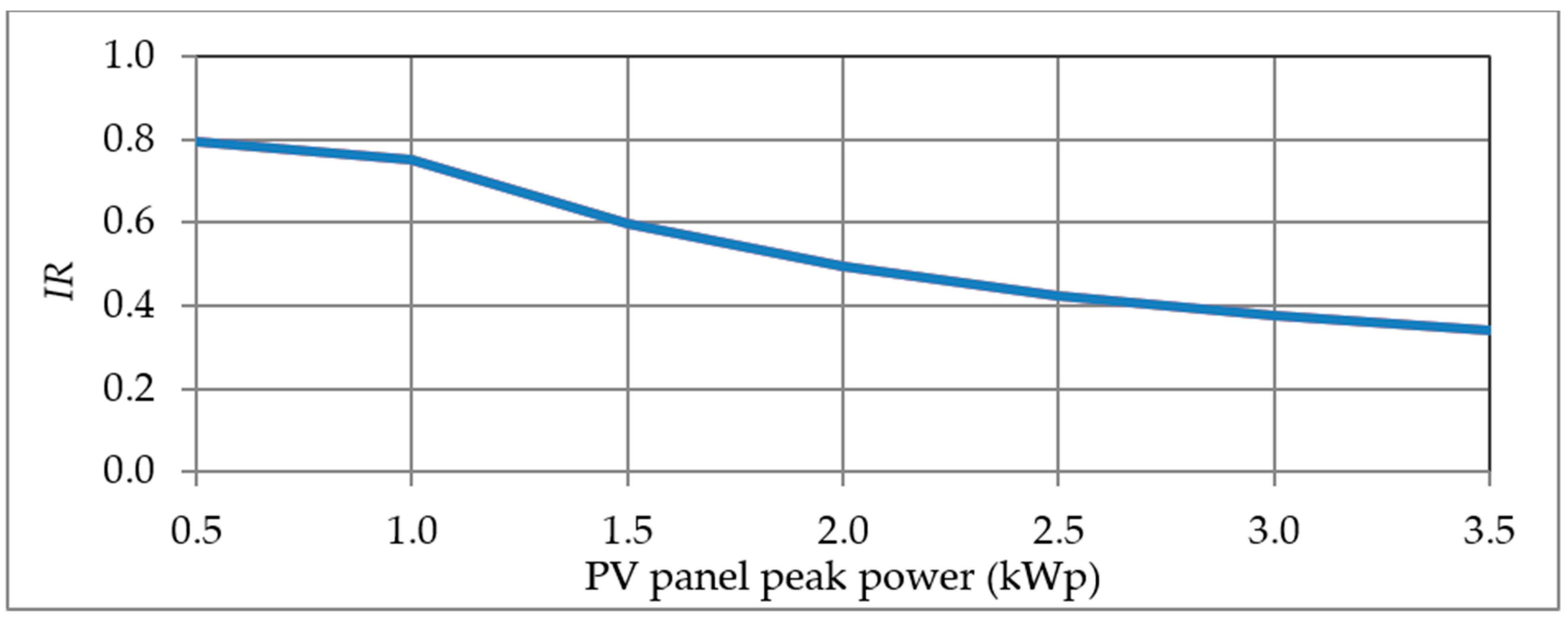
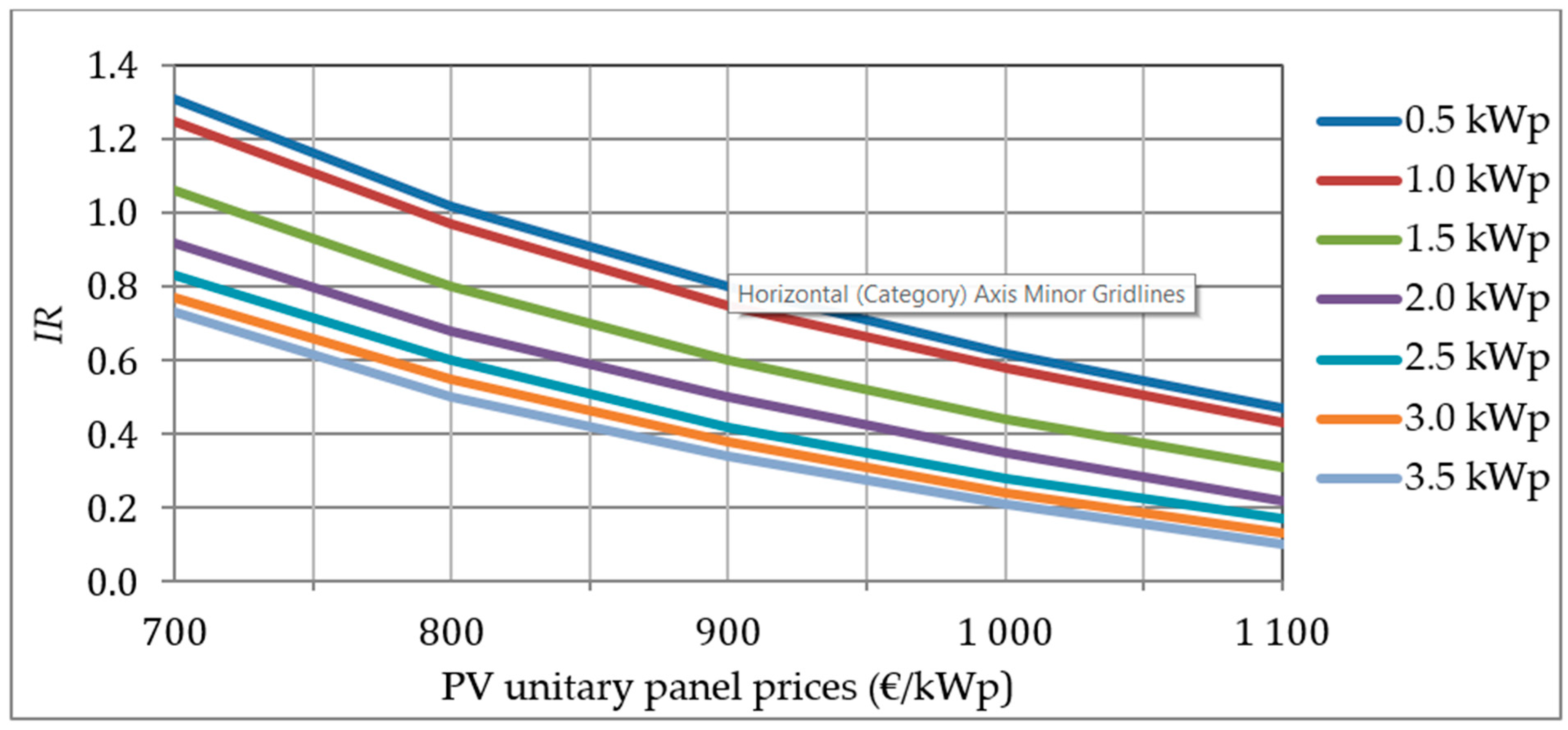



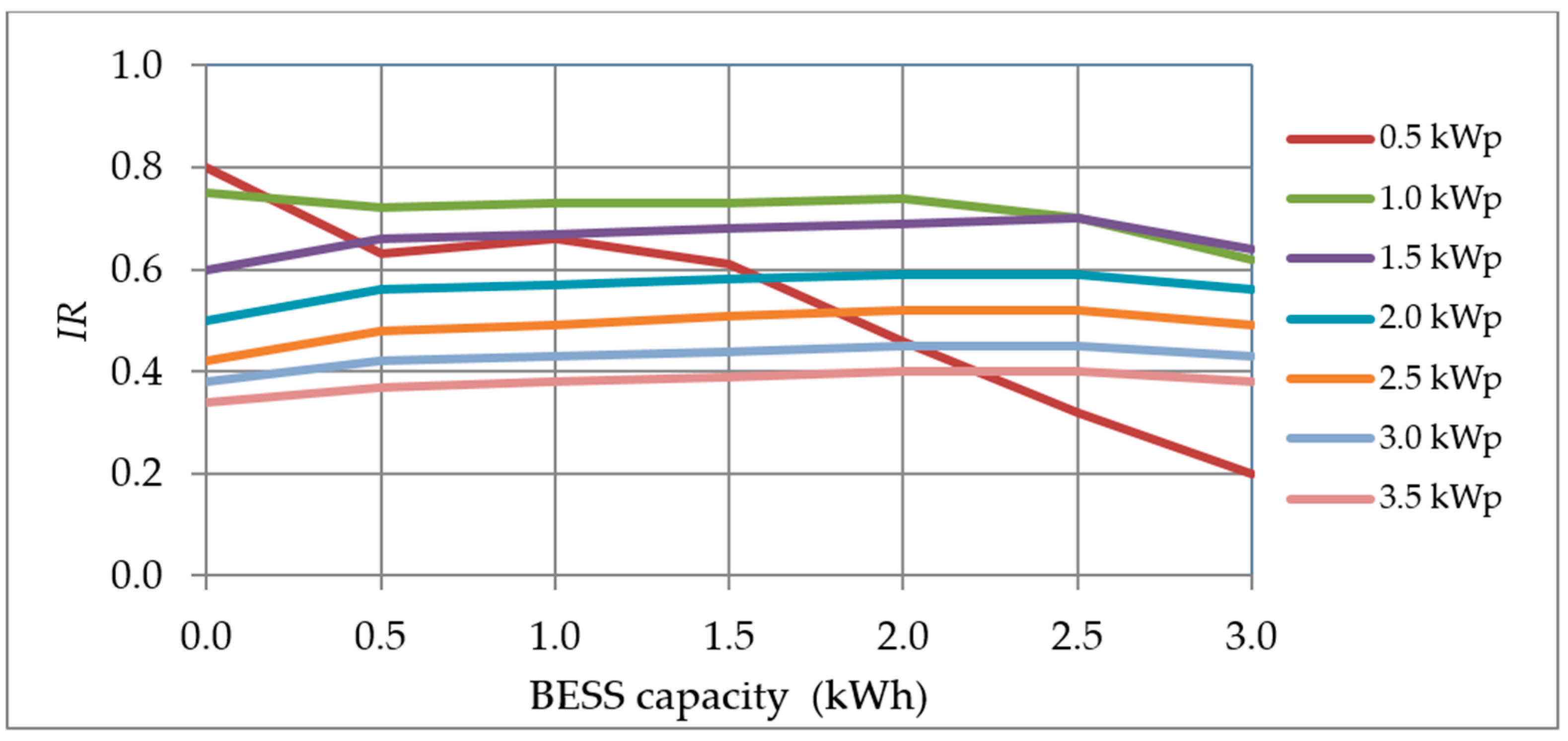
| Scenarios | Operations | ||
|---|---|---|---|
| PV Generation > Domestic Consumption | BESS fully charged | (I) PV consumption + Sale to market | |
| BESS partially charged | Peak hour | ||
| Off-peak hour | (II) PV consumption + BESS charging * * We move to (I) when charging is completed | ||
| PV Generation < Domestic Consumption | (III) PV consumption + BESS consumption (charged or partially charged) + Network consumption (if necessary) | ||
| PV Generation = Domestic Consumption | (IV) PV consumption | ||
| Item | Value | ||
|---|---|---|---|
| Annual demand of the household (D)(kWh) | 3500 | ||
| Contracted Power (CoP) (kW) | 4.4 | ||
| Yearly price of the contracted power (PP) (€/kW) | 38.04 | ||
| Access tariff (AT) (€/kWh) | Winter | Peak (12:00–22:00) | 0.062012 |
| Winter | Off-peak (22:00–12:00) | 0.002215 | |
| Summer | Peak (13:00–23:00) | 0.062012 | |
| Summer | Off-peak (23:00–13:00) | 0.002215 | |
| Item | Value |
|---|---|
| Specific energy (Wh/kg) | 130–147 |
| Energy density (Wh/L) | 250–730 |
| Specific power (W/kg) | 250–340 |
| Nominal voltage (V) | 3.6 |
| Charge/discharge (cycles) | 5000 |
| Monthly self-discharge (%) | 3.0% |
| Round-trip efficiency, η (%) | 92.0% |
| Unitary Cost, (€/kWh) | 100 |
| Shelf life (years) | 12 |
| Item | Value |
|---|---|
| Location (Seville) (º): | 37.389–5.995 (Seville) |
| Database used: | PVGIS-SARAH |
| PV technology: | Crystalline silicon |
| PV installed (kWp): | 1.0 |
| Surface (m2) | 5.0 |
| Number of panels | 2 |
| System efficiency (%): | 18 |
| Slope angle (°): | 34 |
| Azimuth angle (°): | 2 |
| Yearly PV energy production (kWh): | 1599.92 |
| Yearly in-plane irradiation (kWh/m2): | 2187.31 |
(kWp) | (€) | (kWh) | (%) | (€) | (€) | (€) | NPV (€) | IRR (%) | IR |
|---|---|---|---|---|---|---|---|---|---|
| 0.5 | 450 | 798 | 100 | 65 | 0 | 65 | 358 | 14.4 | 0.80 |
| 1.0 | 900 | 1600 | 88 | 122 | 10 | 132 | 676 | 14.0 | 0.75 |
| 1.5 | 1350 | 2390 | 65 | 138 | 42 | 180 | 808 | 12.6 | 0.60 |
| 2.0 | 1800 | 3180 | 51 | 144 | 80 | 224 | 893 | 11.6 | 0.50 |
| 2.5 | 2250 | 3980 | 42 | 148 | 119 | 267 | 956 | 10.9 | 0.42 |
| 3.0 | 2700 | 4770 | 35 | 151 | 160 | 311 | 1 019 | 10.4 | 0.38 |
| 3.5 | 3150 | 5570 | 31 | 153 | 200 | 353 | 1 077 | 10.1 | 0.34 |
| NPV Criterion | IRR and IR Criteria | ||||
|---|---|---|---|---|---|
| Unitary PV Panel Cost (€/kWp) | BESS Capacity (kWh) | NPV (€) | BESS Capacity (kWh) | IRR (%) | IR |
| 700 | 2.0 | 1 012.54 | 0.5 | 17.86 | 1.17 |
| 800 | 2.0 | 912.53 | 1.5 | 15.68 | 0.92 |
| 900 | 2.0 | 812.56 | 2.0 | 14.03 | 0.74 |
| 1000 | 2.0 | 712.63 | 2.0 | 12.64 | 0.59 |
| 1100 | 2.0 | 612.54 | 2.0 | 11.43 | 0.47 |
| 1200 | 2.0 | 512.54 | 2.0 | 10.38 | 0.37 |
| NPV Criterion | IRR and IR Criteria | ||||
|---|---|---|---|---|---|
| BESS Unitary Cost (€/kWh) | BESS Capacity (kWh) | NPV (€) | BESS Capacity (kWh) | IRR (%) | IR |
| 50 | 2.5 | 991.13 | 2.5 | 16.08 | 0.97 |
| 70 | 2.5 | 917.65 | 2.0 | 15.17 | 0.87 |
| 90 | 2.5 | 844.16 | 2.0 | 14.41 | 0.78 |
| 100 | 2.0 | 812.54 | 2.0 | 14.03 | 0.74 |
| 120 | 2.0 | 753.75 | 0.5 | 13.48 | 0.69 |
| 150 | 2.0 | 665.57 | 0.5 | 13.69 | 0.67 |
| NPV Criterion | IR and IRR Criteria | ||||||
|---|---|---|---|---|---|---|---|
| Residential Demand (kWh) | PV Power (kWp) | BESS Capacity (kWh) | NPV (€) | PV Power (kWp) | BESS Capacity (kWh) | IR (%) | IRR |
| 2000 | 3.5 | 1.5 | 867.03 | 0.5 | 1.0 | 13.57 | 0.69 |
| 3500 | 3.5 | 2.5 | 1362.46 | 1.0 | 2.0 | 14.03 | 0.74 |
| 5000 | 3.5 | 3.5 | 1852.06 | 1.5 | 3.5 | 13.87 | 0.84 |
| 6500 | 3.5 | 5.0 | 2228.00 | 2.0 | 4.0 | 14.01 | 0.85 |
| 8000 | 3.5 | 5.0 | 2509.60 | 2.5 | 5.0 | 14.01 | 0.86 |
Publisher’s Note: MDPI stays neutral with regard to jurisdictional claims in published maps and institutional affiliations. |
© 2021 by the authors. Licensee MDPI, Basel, Switzerland. This article is an open access article distributed under the terms and conditions of the Creative Commons Attribution (CC BY) license (http://creativecommons.org/licenses/by/4.0/).
Share and Cite
Ballesteros-Gallardo, J.A.; Arcos-Vargas, A.; Núñez, F. Optimal Design Model for a Residential PV Storage System an Application to the Spanish Case. Sustainability 2021, 13, 575. https://doi.org/10.3390/su13020575
Ballesteros-Gallardo JA, Arcos-Vargas A, Núñez F. Optimal Design Model for a Residential PV Storage System an Application to the Spanish Case. Sustainability. 2021; 13(2):575. https://doi.org/10.3390/su13020575
Chicago/Turabian StyleBallesteros-Gallardo, Juan Antonio, Angel Arcos-Vargas, and Fernando Núñez. 2021. "Optimal Design Model for a Residential PV Storage System an Application to the Spanish Case" Sustainability 13, no. 2: 575. https://doi.org/10.3390/su13020575
APA StyleBallesteros-Gallardo, J. A., Arcos-Vargas, A., & Núñez, F. (2021). Optimal Design Model for a Residential PV Storage System an Application to the Spanish Case. Sustainability, 13(2), 575. https://doi.org/10.3390/su13020575






